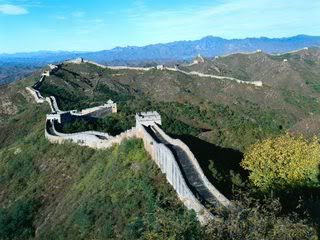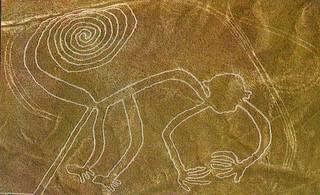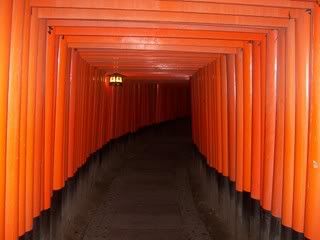
1. The Great Wall of China
This is one that nobody can argue with - not even the highly dodgy text vote denied the Great Wall a place in the New Seven Wonders - although the fact that it exists in the most populous country on Earth can't have hurt it. The largest and longest human-built structure ever, it stretches for 4000 miles along the arc of Inner Mongolia. I've not been there, but it's certainly on my list. Rather naievely I thought there was just one, but apparently there have been a few constructed over the years, the most famous and well-preserved being that from the Ming Dynasty, built after they were walloped by the Mongols in 1449. Sadly, the fact that you can see it from the moon is completely wrong - the smallest individual landmark recongisable is Australia - and even from space it's tough to spot, American astronaut William Pogue thought he spotted it from Skylab, but was later told he was peering intently at a canal in Beijing.

2. Kyoto Station
Next time you're struggling across Birmingham New Street, just think it could be far more difficult. Kyoto station is a vast monument to Japan's favourite pastime - travel - and is one of the country's largest buildings (although amazingly not the largest station, Nagoya's is even mightier). Thirty-five platforms for above-ground trains, plus all the subway going on underneath, it also has 15 floors of shops and offices on top, all enclosed in a gleaming cubical structure that boggles the mind. Opened in 1997 to commemorate Kyoto's 1200th anniversary, it sits uneasily with many locals in their genteel, historic city. But arriving on the Shinkansen and walking into the arrivals hall, it's incredible. You just keep looking up...and up...and up. In the photo above, each kink in the escalator at the top is a separate storey. If the Death Star had a train station, it would look like this.

3. The Nazca Lines
Or as UNESCO has them, the "Lines and Geoglyphs of Nasca and Pampas de Jumana". I'm amazed these drawings weren't on the shortlist of the New Seven wonders thing, they certainly should be. This monkey is 100m across, and is one of the most famous of the figures. The Nazcans removed the dark coloured stones and then trampled the undersoil to give the white outline - but why is a complete mystery. Loony 'experts' have tried to reason that they are the work of alien spacecraft and so forth, as they seem to have been made to be seen from the air, a viewpoint the Nazcans could not have had (which I've got to say is a good point). There are several hundred lines, and seventy recognisable figures, all spread over an area of 200 miles (including a whale - not often seen in a Peruvian desert), and the most widely-held view is that they were parts of a religious ceremony relating to water and crops. And monkeys.

4. Preston Bus Station
'Brutalist Architecture' gets a tough press. The 1960's spawned many a concrete monstrosity, but all that was forgiven in 1968 when the sleepy Lancastrian county town woke up to find this for a transport hub. Preston Bus Station, the longest in Europe (take that, Bratislava!), certainly the most confusing to the eye - it looks like it goes off into the horizon for a thousand miles. It has a capacity for 80 double-decker buses and 1100 cars, with the scalloped edging protecting people from the frequent elements as they wait. Appallingly, this wonder is scheduled for demolition, as it's old and hard to get to, and not 'functional'. Well, neither are the Nazca Lines, Preston City Council - would you demolish those too? Save Preston Bus Station!! (local fact - there's actually no number 40 service, the bus parked there will be an additional 35 service to Tanterton waiting for the correct bay to become free).

5. Fushimi-Inari Taisha
Inari is the Shinto god of rice, and as such in Japan there are shrines to him everywhere - but none more stunning than the Fushimi Inari shrine south of Kyoto. The vermilion-coloured torii gates are instantly recognisable symbols of Japan, and mark the entrance to a sacred spot - just one, usually. Fushimi has tens of thousands, stretched over a wooded hill en route to the shrine. They are squashed in, touching each other, like orange dominos - it would take you two hours to walk under them all. I went there one evening in 2005, when the light was just going, and wandered up the hill through this tunnel for about an hour, catching glimpses of trees, lanterns, and small statues of foxes (Inari's messengers), but only glimpses, it was like walking along a mine tunnel. I don't have a spiritual bone in me, but it was utterly breathtaking.

6. Bully's Prize Board
Just think about this one - it had a dart board, a question board, and the prize board - and in the time it took to revolve many rash decisions were made. Of course, they were all either prefaced with "Well Jim, we've had a lovely day..." (take the prizes), or "Well Jim, we came here with nothing..." (gamble!). But would you take a chance at 101 or more with six darts (non-dart player to throw first), and risk losing your Grundig hifi, spin dryer, and set of patio furniture? You've got all the time in the world to throw that first dart - but if it goes wrong, Jim shows you - and he hates to, but he has to - he shows you what you could have won. And when that beige Austin Maestro, or sparkling speedboat is wheeled out, and the studio audience groan, you've got nothing but your tankards and bully's, and your BFH to show for it. But that is the gamble of Bullseye...

7. Scarlett Johansson
I suppose techincally she would be a natural wonder of the world...
Satellite images of the Great Wall of China
YouTube clip from the top of Preston Bus Station
Bullseye on Wikipedia
Photographs of Fushimi Inari Taisha
DUaB's Seven Wonders of Scotland